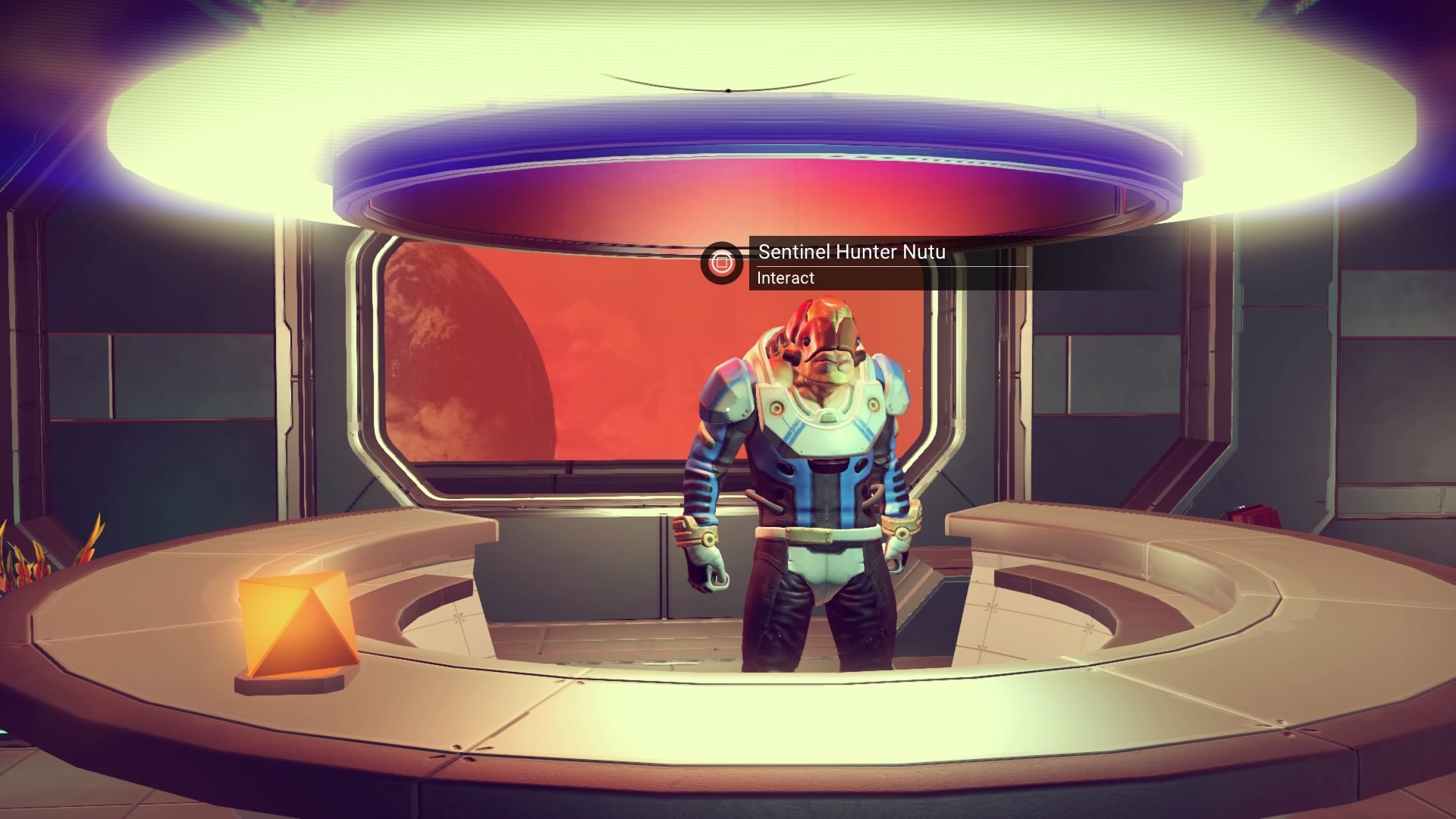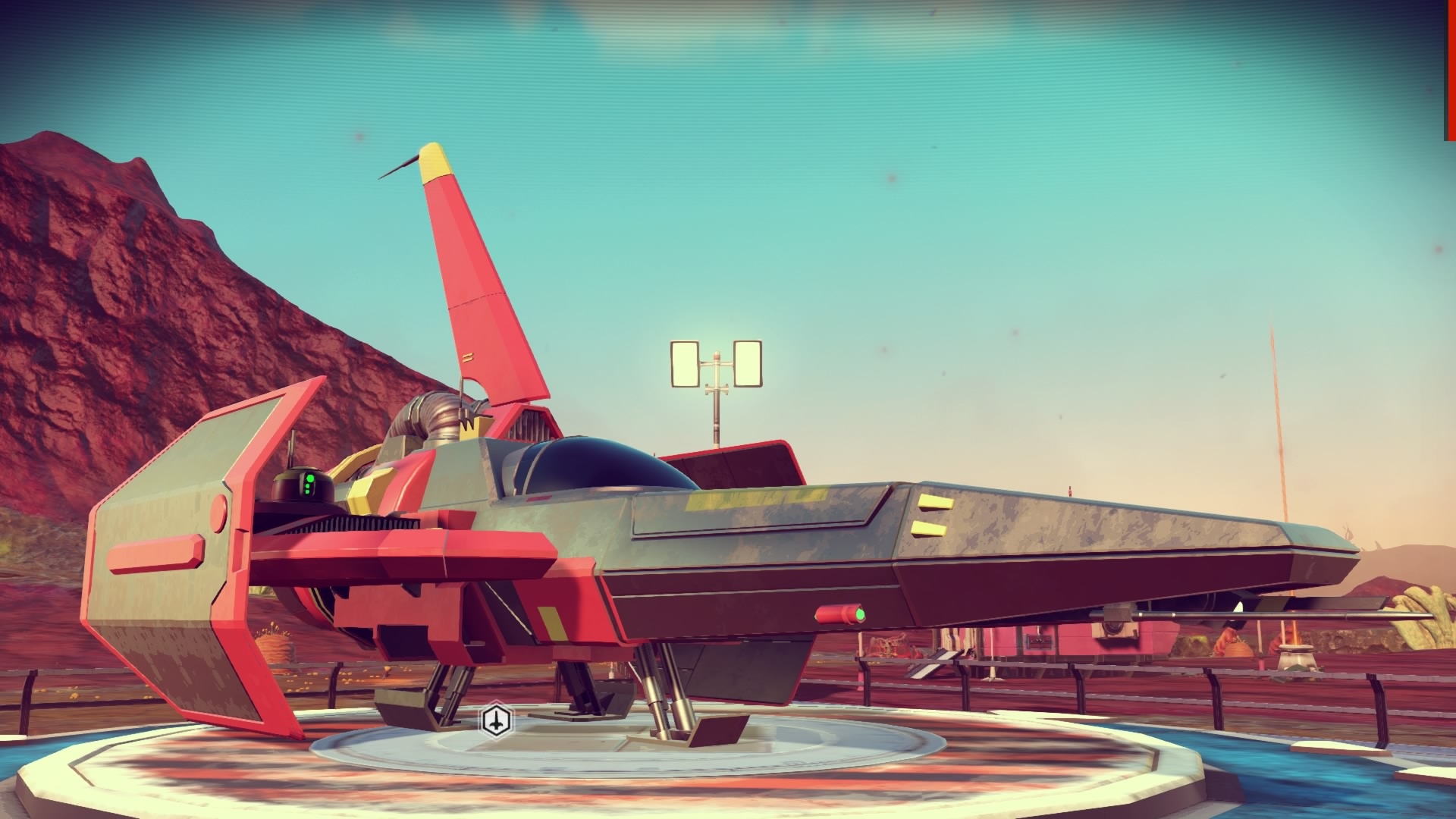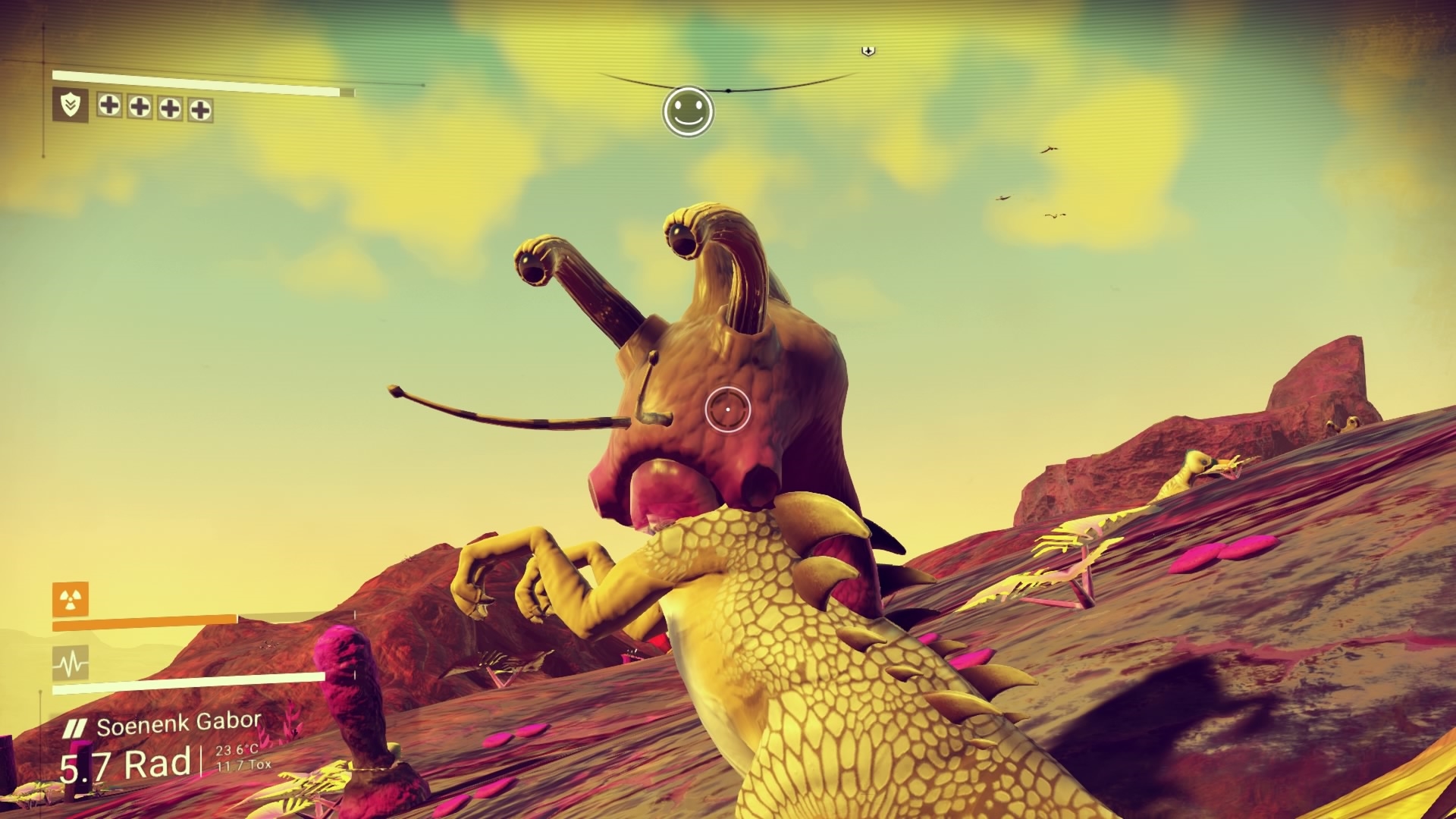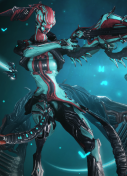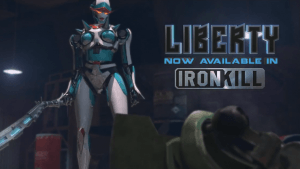No Man’s Sky Review (PlayStation 4)
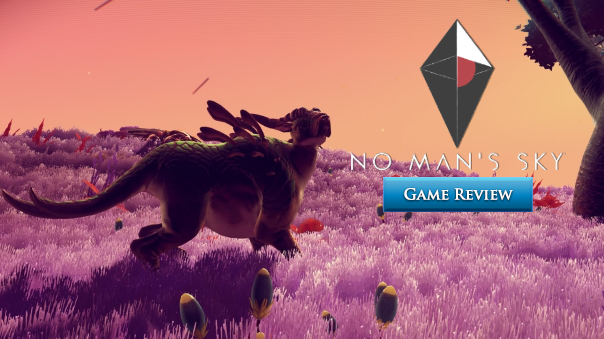
I’ve reviewed dozens of games in my career, ranging from the truly awful to the genuinely amazing, yet none of those reviews prepared me for No Man’s Sky. On the surface, this new sci-fi sandbox title from Hello Games seems straightforward and simple. But beneath its technicolor dreamcoat surface, No Man’s Sky is a messy tangle of half-truths, discarded features, poor public relations, derailed hype, and a community divided to extremes.
Reviewing the game without addressing its bloated entrails seems the most logical approach, but it is also the most shallow. On the other hand, going too deep into the offal would require a series of essays and leave everyone covered in the resulting shit. Balancing these factors isn’t just a reviewer’s problem, either – it’s the problem faced by every gamer invested in No Man’s Sky. The conclusion I have come to: this No Man’s Sky review will be long, refer to many other sources and articles that have already elaborated on some issues, and try to give a reasonable cross-section of the game as a whole, from design to experience. This review also comes a month after the game’s release, allowing time for Hello Games to react to the initial excitement and for the community to discover more of the universe than a few hours of gameplay can provide.
Welcome to the multiverse of No Man’s Sky.
What is No Man’s Sky?
No Man’s Sky, developed and published by Hello Games with the assistance of Sony Interactive Entertainment, is at its core a procedurally generated science fiction open world game. It’s priced at $60 USD, available on PlayStation 4 and PC. There is no cross-platform play (meaning both systems have identical but separate universes), and the existence of multi-player is a tricky issue to be discussed later.
The game’s most unique aspects are its procedural generation and vastness. Everything from the structure of the universe itself to the creatures, plants, and minerals found on each planet has been created randomly through an impressive game engine. While some content naturally exists as created by the development team (the art assets, in game dialogue and narrative), most of what players experience is the mathematical result of those elements being constructed into an explorable, interactive universe.
That is not to say, however, that the universe is being freshly generated randomly (as it might be in a rogue-like game). No Man’s Sky’s universe is static and persistent, much like an MMO. It is, however, also vast to the point of being billed as “infinite.” That is not technically true – according to Hello Games, there are over 18 quintillion planets – but for mortals, it might as well be infinite. Just to visit all of those planets would be well beyond any person’s lifespan. But it isn’t just the universe itself that’s large: each planet would take hours or even days to circumnavigate on the surface. A player could, theoretically, spend weeks cataloguing everything on a single planet.
The most important take-away from No Man’s Sky is this: it is the largest persistent universe and game world ever created. None of the ugliness and drama about the game can take away from this fact. It is a technological marvel with infinite playability (as replayability isn’t even necessary). It is a massive digital universe that is capable of making players feel small and insignificant among the cosmos. It has made video gaming history.
No Man is an Island
Enter the player: a lone traveler in this theoretically infinite digital cosmos. There is no created identity, no customizable avatar – not even a third person mode in which to look upon the Traveler. The Traveler has no distinct identity and becomes a blank slate for the player to use to explore. That is not to say, however, that the Traveler has no identity – but this is one of the mysteries that may be uncovered playing the game.
No Man’s Sky has no traditional story by design. Instead, the universe is populated with three alien races: the lizard-like Gek, the warmongering Vy’keen, and the technological Korvax. These aliens man space-stations, outposts, and ships in the universe. Players will discover knowledge stones, which teach the Traveler the languages of these species, and monoliths, which often uncover the stories of these races. These discoveries gradually give players a sense of place and understanding (or speculation).
There are two other major factions that the Traveler will encounter: the Atlas, and Nada & Polo. To say much more than this can be a huge spoiler, but they can be thought of as two different paths to take in the player’s exploration of the universe. Though it has often been told that getting to the center of the universe is the player’s goal, this is actually one of possibly multiple choices. The claim that there are multiple endings, however, is deceptive: in so far as players have discovered in the weeks since No Man Sky’s launch, the end result – essentially a “New Game+” mode – is the same, just presented differently.
Here, now, are where two deeper issues come into play: the status of the game’s multiplayer, and the existence of the alien races in the game.
One of the first massive debates that exploded on the Internet about No Man’s Sky was in regards to multiplayer, a feature that was specifically mentioned by Hello Games during its development. The game, however, is lacking any sort of player interactions. Players are able to discover systems and planets named by other players (one of the features that lets players make their mark on the universe), but they are not finding other players. This was compounded by players who met up in the online world only to not be able to see each other.
Hello Games, however, has remained generally vague about the game’s multiplayer, and has yet to explicitly state if this is possible or if the only intended multiplayer aspects are the naming of discoveries. While players have discovered that they can sometimes discover each other’s graves, datamining has also been unable to find anything in the code that would enable even the most basic multiplayer elements. It is worth noting that multiplayer was also only confirmed in the vaguest of terms (that it would exist, and that players might run into each other but it would be very rare). Any expectations beyond this were merely speculation and rumor. The message, in general, seems to be pointed toward the single-player experience, leaving many who crave a more distinct multiplayer element dissatisfied.
No Man’s Sky also promised depth to its faction system, indicating in press demonstrations and interviews that alien races would have different benefits and players could ally with them, both in interactions and in space battles. However, this depth is clearly lacking. Factions have a small reputation scale that is easy to max out (less than a dozen interactions can get you there), and seem to offer no actual benefit such as faction discounts or unique obtainable tech or gear. Space battles, while they do occur, seem to only be battles between pirates and other factions with no indication of actual faction war. The Traveler can easily befriend all three factions with no consequences or affect to the other – indeed in my own travels, I have been able to assist the Vy’keen in clearly aggressive acts against the Gek, which has increased my standing with the Vy’keen but done no harm to my standing with the Gek. Aliens, instead, have become static NPCs, existing only at certain terminals. They do not roam planets (except in ships which they never exit), issue quests, or become hostile. Aliens serve merely as optional interactions for players to earn rewards obtainable in other ways, a semblance of “intelligent life” for players to interact with.
Land of the Lost – Ruled by PETA
On the ground, each planet is its own complete ecosystem. As each planet is randomly generated, most are imaginative and varied, ranging from the Earth-like to the barren, from planets mostly land to mostly water. Each planet has different survival conditions, and severe storms, radiation, toxicity, and temperatures can put the Traveler at risk. Luckily the Traveler has two protection systems, a Hazard Suit and a Life Support system. These both are charged up fairly easily with common elements found on all planets, so there is rarely a true threat from the environment.
While I do call these planets “varied,” it should be noted they are not diverse. Planetary features any earth scientist would expect – volcanoes, mountains, and sand, for example – are completely missing, even despite being seen in trailers. Planets also lack geophysical properties. There are no flowing waters, no gravity differences, no natural disasters. Planets may play host to multiple biomes with varying properties, but most can simply be divided between land and water. In short, nothing has the diversity or complexity of our planet Earth.
Planets are populated with flora and fauna to varying degrees. What flora and fauna these are seem to be at the whim of the procedural generation, though there were indications in the game would feature scientific resource and life placement. In both categories, planets can range from devoid to lush. A great deal could be said on the diversity of flora and fauna specifically, so it is easier to say that the system’s end result is a little bit of Impossible Creatures meets Spore: parts stitched together onto a 3D rig so that they can function relatively normally. I say relatively, because despite this, some creatures fail to do what they should, such as this pulsing jellyfish which decided to become a land creature, spawned in a group, and glitched, resulting in, well, this:
In the first dozen or so hours of playing No Man’s Sky, the diversity may feel particularly lacking: it’s the same dog-creature, deer-creature, bird-creature, crab-spider, recycled in new ways but ultimately recognizable despite. However, the further players explore, the more diverse and strange life-forms we encounter: fat goblins with butterfly wings, floating tentacle monsters, and a multitude of science experiments gone wrong. But while the fauna, and even most of the flora, tries to be different, other factors fail. Elemental flowers are color coded and look relatively the same, along with thousands of varieties of stalagmites, boiling pools, jutting iron crystals, and glowing flowers (not to mention “poo rocks” and “space lettuce”). Just like every outpost, shelter, and space station seem to be identical regardless of which race built them, only in different (and often neon) colors, and mineral deposits mostly stand out as the same glistening metallic pillar or nugget on each planet. While this does grant some reliable familiarity for the Traveler as they go on endlessly through light years of systems, it also results in a growing tone of homogenization.
Presiding over planets (and space, too) are the Sentinels, robotic creatures which patrol the entire universe with an overarching goal to preserve peace on every planet. On most planets, the Sentinels’ small drones will wander, coming over to the Traveler in concern if they destroy resources or creatures. For whatever reason, the Sentinels have a strange sort of AI in which they value iron and carbon (the two most common elements) to such a degree they get agitated if the smallest rock breaks, while they will wander by unphased if the Traveler is destroying a massive deposit of rare elements. On some planets, the Sentinels are highly aggressive and will simply attack on sight. While Sentinels are meant to offer a deterrent to players stripping resources, they mostly remain an annoyance easily dealt with. The Traveler’s limited inventories do a far better job at restraining the player’s entrepreneurship.
So where has NMS fallen short for players in terms of planet life? The list is relatively long, but includes a lack of megafauna (such as the preview dinosaurs), creatures not affecting or interacting with their environment in a meaningful way, a limited lack of 3D rigs that affect final creature models, and strangely aggressive creatures (insect eaters attacking the Traveler, for example). While the joy of discovery remains, much of it has resulted in laughter rather than awe. Additionally, the odd AI and relatively unthreatening Sentinels have also not behaved as shown in past presentations. Ultimately, even when planets do not look the same, they behave in too-predictable patterns. Exploring becomes less and less a time for joyful discovery and more and more a hunt for something the player just hasn’t seen yet.
That, and the hunt for the elusive giant sand worm.
All I Ask Is A Tall Ship (And Stars to Steer Her By)
Naturally, a game about exploring planets features spaceships and space flight. Thankfully, Hello Games delivered on some of its promises of the space flight experience. Unfortunately, it’s as if the developer told players they’d get cake, and in the end gave players a Twinkie. Sure, a Twinkie is technically a cake, but it’s so far removed from the conceptual idea of “cake” that it leaves the door wide open for that classic Portal meme.
Let’s start with the player’s starship. Initially players are given a crashed starship they must repair to begin their journey using materials they can find around them on the planet in a cleverly disguised tutorial. This ship is little and offers only the most basic tools players need to embark upon their space journey: a photon cannon (for combat), a phase beam (for mining asteroids), a shield (for defense), a launch thruster (for taking off from planet surfaces), and parts of a hyperdrive (for extremely fast travel and moving between galaxies). As players explore they will discover additional technology blueprints that allow ships to become better equipped to handle the dangers of space travel, along with the precious Warp Drives which enable travelling to different types of star systems and jumping longer distances.
Like the player’s inventory, a starship’s inventory is limited. But while the Traveler can purchase upgrades to their Exo-Suit inventory, the starship must be replaced to expand its territory to hold more upgrades and items. Players have two options: find and repair a crashed starship on a planet, or purchase a “gently used” starship from an alien. This system does allow you to transfer your inventory between ships before accepting the new one, but it does not allow the transferring of upgrades – meaning some may need to be built again in the new starship if desired. (The Traveler also has a multi-tool which operates similar to ships in this regard, but without the repair mechanic.)
Despite some early reports at launch claiming there were no differences between any starships, there are actually three ‘classes’ of starship: light, medium, and heavy. Light ships have more maneuverability and speed but less durability; heavy ships have the highest durability and less maneuverability and speed. Medium ships naturally fall between. There may also be other factors that affect ship performance, which have yet to be objectively tested (and have proven difficult to do). Ultimately, a ship’s type can be determined by the appearance of its cockpit. Size and shape are procedurally generated and can be deceiving, both in ship class and in inventory size.
Space flight itself is at its best tolerable. While the controls are relatively easy to learn, starships simply don’t handle with precision or finesse. This is most evident on planets, where a banking turn can end up with a ship flipped upside down and out of sight of its original destination. In fact, Hello Games chose to disable low-altitude flying (PSA: there’s a mod for that) and the ability to hover (your ship is always in momentum, be it forward or backward). Ship landing is even automated, both in landing on the ground on planets and in the space station.
In space combat, the controls become a little more natural. However, space combat itself is quite limited in its approach. Starships always take a basic dogfighting path, making it easy to predict their moves and dodge their attacks with some practice. Once again there are many lacking features to make a ‘good’ experience: no target lock mechanism, no reliable auto aim except with the phase beam, a poor radar, and no control over friendly fire. This means that space pirates who will, inevitably, pull you into battle, become a great annoyance.
As for the massive space battles promised? To begin with, they do not take place between the game’s three factions – only between one faction and space pirates. Players can choose to side with the pirates or the faction, although neither ‘ally’ will come to the player’s aid or show any interest in the player’s participation at all. However, friendly fire means that a single missed shot can either bring down a squadron of pirate ships on your head or, worse, warp in Sentinels to add another hostile squadron to deal with. The battles are also toned down from the press demos, which might be understandable – if the core gameplay had maintained its expected quality.
It’s fair to note here that Sean Murray, head of Hello Games, has emphasized multiple times in his interviews throughout the past couple of years that No Man’s Sky is not trying to be like Destiny or Elite: Dangerous, even to the point of encouraging players to go to those games if that’s the experience they seek. The problem with No Man’s Sky isn’t that is gameplay doesn’t compare to other sandbox space games on the market. The problem is that the game failed to live up to reasonable expectations among its fanbase, causing a massive schism that Hello Games, not hype, is at fault for.
Wrong Way on a One Way Track
The real problem with No Man’s Sky isn’t its price point, or even in its list of missing or truncated features (documented best at One Man’s Lie, though this list is out of date). Nor can players simply be blamed for hitching a ride on the Hype Train, though hype certainly plays a part in this story. The problem lies in vague marketing, ambiguous communications, and a general lack of transparency from Hello Games.
If it hasn’t been obvious yet, the list of grievances against No Man’s Sky all boil down to the same format: Hello Games presented a feature (through interviews and promotional media), and the feature cannot be found in the current version of No Man’s Sky. The result has been a tangle of misinformation, exaggeration, anger, fact, philosophy, and digital violence – practically a mid-life crisis of the gaming community. All of this only became more intense days after the PlayStation 4 release, when the PC version launched with a host of bugs and connectivity errors that took days to smooth out. It’s easy to understand, then, why “No Man’s Lie” became a popular term across social media, YouTube, and even gaming press. And while some developers and industry gurus decided to brave a defense of Hello Games, the developer remained quiet under its assault, pointing to a focus on stability and quality of play first.
The likelihood of the matter is that Sean Murray and Hello Games did not lie by intention. The Occam’s Razor of this situation in the video game industry is that these features were in development but, somewhere before release, were removed from the game for logical design reasons. Glitches, bugs, balance issues, engine limitations, and general quality of play all can play a factor in a feature’s ultimate removal from a released game. That some of these features seemed to be working in press demos further indicated that they were not imaginary selling points for the game.
Lies by omission, however well-intended, certainly are a fair accusation to make toward Hello Games. When a developer is forced to make these cuts, they are under an ethical obligation to disclose them. However, Hello Games has never confirmed any features removed from the game, even after a month’s release. Certainly some missing features – like planets with rings or landing on asteroids – are minor issues and hardly worth throwing the developer in the electric chair. Others, like the exact multiplayer features or the seemingly unusable portals, do require specific clarification from the developer and yet, a month later, remain unaddressed. Indeed, an entire ARG took off from one fan’s intentionally mysterious interactions with the reddit community in order to try to uncover the secrets of the portals, and while nothing of value has yet been discovered, plenty of players are ready to hang up their hats and simply say “They don’t work.” After all, there is no evidence that portals do work, and not even a simple statement from Hello Games indicates whether they are still working or exist currently as merely forgotten monuments.
Hello Games’ air of mystery can best be seen in the case of the giant sandworm, a mighty creature seen in an early trailer that was supposedly miles long. While players struggled to find massive megafauna, Sean Murray answered the question of their existence in an AMA thusly:
Oh man, I hate questions like this, because like wouldn’t you just rather discover for yourself? Huge creatures are out there, and I haven’t seen them on streams yet. They are rare.
Certainly the explorers and discoverers of No Man’s Sky appreciate the joy of discovery. But as days turned to weeks, with no confirmed sightings of any creature taller or longer than 7 meters and no sign of a sand planet, players certainly have to wonder: is Sean Murray blowing smoke? Just how rare is this creature, in a universe of 18 quintillion planets? Is it so rare that the community has been unable to locate anything remotely close to this monstrosity?
Communication with players has also been haphazard. While the Steam community gets regular patch notes, PlayStation 4 does not and must wait until they are posted on the Hello Games website some time later (often after a week or more has passed). Updates have been posted to Hello Games’ official Twitter, but not to @NoMansSky (which, as it turns out, is Sean’s personal twitter account). Whatever the reason, the way in which Hello Games communicates with its players and potential customers is vague and inconsistent.
It’s that fault of Hello Games – from the years before the game’s release to the day of this review’s posting – that has summoned a dark cloud over No Man’s Sky. The developer’s inability to clarify actual game features, their marketing lingo and “I can’t tell you” attitude, has only led to chaos and confusion among the community. It is what has allowed misinformation about the game’s actual state of affairs to spread rampantly across the gaming community at large. It has tainted dedicated communities with acidic cynicism. And, most importantly, it allows people to claim that No Man’s Sky is a bundle of broken promises – because Hello Games has yet to come to its own defense. In doing so, Hello Games has fallen on its own sword, allowing its reputation to be destroyed by silent resignation to a gaming community gone mad.
Final Verdict: Good (3/5)
Even if you extract all the drama and ignore the missing pieces of the puzzle, No Man’s Sky remains incredibly average in its current incarnation. The four videos leading up to the game’s release promoted four key concepts: Explore, Fight, Trade, and Survive. But in all of these areas, NMS merely does its job adequately.
Players can explore, but the joy of exploration and discovery is limited by too few parts in a procedural engine. Players can fight, but controls are basic on land and in space, and fights are often too easily resolved. Trading exists, but at the most basic level of buying and selling items on a global market without a way to establish routes or track prices. Survival itself, while challenging at first, is quickly mastered as the player unlocks blueprints and learns tricks that make any threat negligible.
The end result is that No Man’s Sky has elementary gameplay that is more rewarding as a relaxing casual title than as sci-fi sandbox survival. In fact, the gameplay would be quite welcoming to casual players and a broad audience with the right marketing and a lower price point. However, for the terrible mess that No Man’s Sky’s launch has been, and for the $60 price tag on a game that has less complexity than some early access titles like ARK, the game simply cannot warp back in time. At the very least, the PC version allows modding which has greatly improved the game’s interest for those who can enjoy it.
Beyond all of this nitpicking over gameplay and marketing, No Man’s Sky is a truly beautiful game, one deserving to be recognized as a piece of art. Yes, despite all of these issues, there is no denying the mastery of the simple experience of playing No Man’s Sky. Each world offers beautiful vistas filled with colorful materials, fauna, and flora. The game’s lore, uncovered through various small tidbits, is written masterfully and exposes what can be a truly disturbed and psychological backstory. For those who are able to accept No Man’s Sky for what it is – incredibly average, overpriced, and undefined – an incredible journey awaits.
No Man's Sky Review Gameplay Screenshots
Articles You May Enjoy
- TERA Reveals Upcoming 'BAF Masters' Update
- The final update for the Action MMORPG for PC, TERA has officially been announced - BAF Masters!
- Block N' Load Hosts Valentine's Day Weekend
- Big bombs are red, acid is green; Eliza and Tony make a cute/deadly team! Love is in the air in Block N Load this weekend, with the launch of ...



